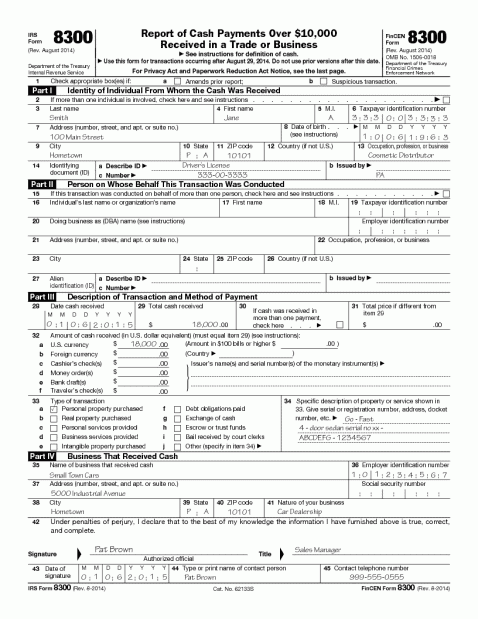IRS Form 8300 – The Definitive Guide
JW
Last updated 03/19/2024 by
Jessica WalrackMost transactions leave digital footprints which make them easy to track. But once in a blue moon, people still make large purchases with cash. If you are the payer or payee of a cash transaction on U.S. soil that exceeds $10,000, here’s what you should know about IRS Form 8300.
Read on to learn the answers to the following questions:
- What is IRS Form 8300?
- When is Form 8300 required?
- How do you file form 8300?
- What happens if you don’t file Form 8300?
- Where can you get help with Form 8300?
Compare Tax Preparation Services
Compare multiple vetted providers. Discover your best option.
What is IRS Form 8300?
IRS Form 8300 is a Report of Cash Payments Over $10,000 Received in a Trade or Business. It’s required for U.S. persons (individuals, companies, corporations, partnerships, associations, trusts, or estates) who receive cash payments that meet the following criteria:

- The cash payment is greater than $10,000.
- The transaction occurs in a U.S. state (or the District of Columbia), a U.S. possession, or U.S. territory.
- One agent or buyer provides the full cash amount.
- The recipient receives the cash in the ordinary course of their business or trade.
- The cash is received as one of the following:
- A lump sum.
- Installment payments within one year of the initial payment.
- Prior unreported payments that cause the total cash received to exceed $10,000.
- The transaction is either:
- Made in coins and currency of the U.S. and/or a foreign country.
- A designated reporting transaction made using a money order, bank draft, cashier’s check, or traveler’s check.
If you receive a qualifying cash payment, you must file Form 8300 and furnish a written statement.
Why is Form 8300 necessary?
Form 8300 informs the IRS and Financial Crimes Enforcement Network (FinCEN) when large cash payments are made in an effort to help combat money laundering.
When do I need to furnish a written statement with Form 8300?
When filing Form 8300, you must furnish a written statement to the people whose names you include on the form. This includes the payer and any person who had the transaction conducted on their behalf (when applicable).
The letter must include three parts:
- The name, address, and phone number of the person filing the form (you).
- The amount of cash you reported on Form 8300.
- Acknowledgment that you are reporting the payment to the IRS.
You must furnish this written statement by January 31 of the year following the transaction. Also, be sure to keep copies of the form and letter(s) on file for five years.
When is Form 8300 due?
If the law requires you to fill out IRS Form 8300, you must do so within 15 days of the date of the cash transaction.
How do you file Form 8300?
You can file Form 8300 online or via the mail.
To file online for free, head over to the Bank Secrecy Act (BSA) Electronic Filing (E-Filing) System.
You can also find the form here, print it, fill it out, and mail it in.
What does Form 8300 include?
Form 8300 asks for the following information:
- Identification of the individual who sent you the cash.
- A description of the transaction and payment method.
- Information about the recipient of the cash.
In addition, if you conducted the transaction on someone else’s behalf, you must include their information as well.
That’s it!
What kind of transactions can trigger a Form 8300?
Any single cash transaction or series of related transactions whose cumulative total exceeds $10,000 will require a Form 8300! These may include:
- Repaying a loan.
- Renting real or personal property.
- Selling goods, services, real property, or intangible property.
- Currency exchanges.
- Payment of pre-existing debt.
- Reimbursement for expenses paid.
“Related transactions” are multiple connected transactions. If you know that multiple transactions are related, and they net to more than $10,000, you must consider them a single transaction and report them on Form 8300.
For example, say a travel agent has a customer who pays $8,000 in cash for a trip. Then, two days later, the customer returns to add another traveler to the itinerary for another $4,000. These transactions are related, and would both count toward the $10,000 requirement.
Further, cash transactions are automatically considered “related” if they occur within a 24-hour period.
What happens if you don’t file Form 8300?
If you fail to file Form 8300 or the accompanying written statements, you could face civil and criminal penalties. If you willfully abstained from filing Form 8300 or attempted to obfuscate a transaction, the penalty is greater than if it was a mistake. Read this article to find out how to get tax penalties waived.
Need help with Form 8300?
Do you still have questions about IRS Form 8300? Not to worry. Tax preparation experts are standing by and can make sure that you file everything necessary. Further, they can represent you and protect your interest if anything goes wrong.
Are you looking for information on another IRS form or notice? Check our comprehensive guide on IRS notices.
JW
Jessica Walrack is a personal finance writer at SuperMoney, The Simple Dollar, Interest.com, Commonbond, Bankrate, NextAdvisor, Guardian, Personalloans.org and many others. She specializes in taking personal finance topics like loans, credit cards, and budgeting, and making them accessible and fun.
Share this post: